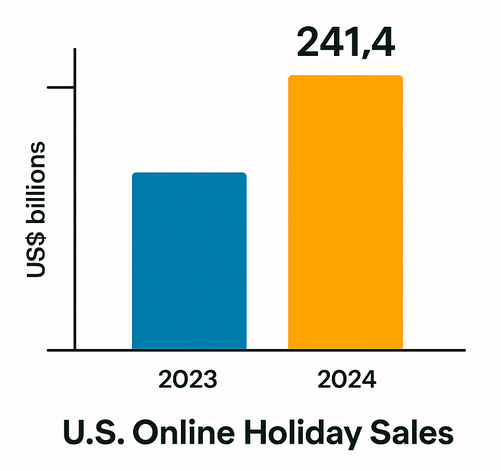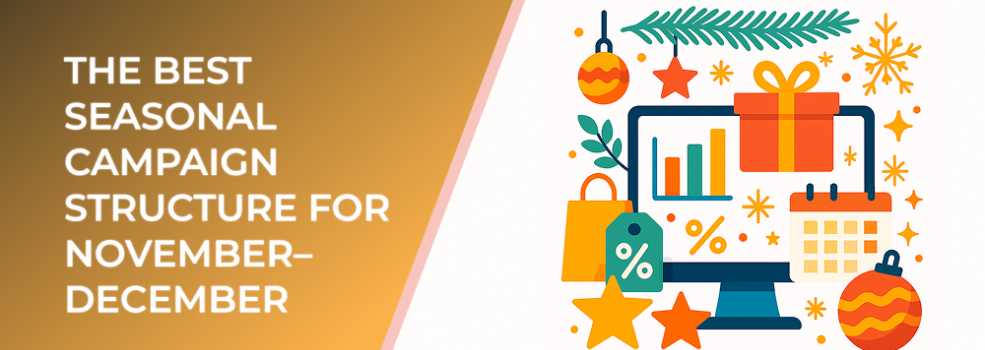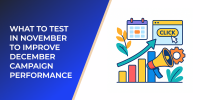The November–December period remains the highest-value advertising season of the year. Global shoppers spend nearly 30% of their annual online budgets during these two months, and ad competition increases accordingly. With costs rising sharply around key shopping days, having a structured, predictable campaign system is essential to avoid overspending and missing revenue opportunities.

U.S. online holiday sales grew from ~US$222 billion in 2023 to US$241.4 billion in 2024 (+8.7 %)
Below is a proven campaign structure designed specifically for the holiday surge, ensuring stable delivery, optimized audiences, and clear budget sequencing.
1. Pre-Peak Warm-Up (Early November)
The goal of early November is simple: warm your audiences before competition spikes.
What to run
-
Awareness campaigns focused on reach or video views
-
Low-cost engagement (landing page views, post engagement)
-
Audience-building campaigns that expand retargeting pools
Why it works
-
CPMs in early November can be up to 25–40% lower than the days right before Black Friday.
-
Engagement-based remarketing pools often grow 3–5x faster during this period due to higher shopping intent.
Recommended segmentation
-
Cold audiences (broad, lookalikes)
-
Warm audiences (website visitors, engagers)
This warm-up stage becomes the foundation of your peak-period conversions.
2. Black Friday–Cyber Monday (BF/CM) Push
This is the most competitive and profitable stretch of the season.
What to run
-
Conversion campaigns optimized for purchases
-
High-intent retargeting with short-time windows (1–7 days)
-
Offer-based creative variations to match urgency
Key considerations
-
BF/CM CPMs can increase up to 2–3x.
-
Conversion rates rise sharply—many brands see 2x–4x higher daily purchase volume.
-
Retargeting typically delivers the highest ROAS of the entire season.
Funnel setup
-
Cold: Keep only top-performing cold campaigns active to maintain efficiency.
-
Warm: Use all fresh November traffic with tailored messaging.
-
Hot (1–3 days): Prioritize urgency and scarcity.
3. Early December Cooldown + Retargeting Recovery
After Cyber Week, ad costs usually dip for 7–10 days.
What to run
-
Mid-funnel retargeting for users from the November warm-up
-
Restocked or evergreen product creatives
-
Add-to-cart retargeting with incentives
Why it works
-
Conversion rates stabilize but remain 10–20% higher than non-holiday months.
-
Ad competition decreases, lowering cost per purchase.
This period helps recover missed buyers who were overwhelmed by BF/CM noise.
4. Last-Minute Shopping Window (Mid–Late December)
This window captures shoppers who purchase later or need last-minute gifts.
What to run
-
Urgency-based messaging (shipping deadlines, bundles)
-
Gift-focused creative
-
Retargeting of all December website visitors
Performance notes
-
Many brands see a 20–35% spike in daily conversions** during shipping deadline week.
-
CPMs rise again as advertisers fight for remaining high-intent buyers.
5. Post-Holiday Remarketing (Late December)
Once gift-opening ends, interest in self-purchases rises.
What to run
-
Upsell and cross-sell campaigns
-
Post-purchase flows
-
Interest rebound retargeting for users who browsed but did not buy earlier
Why this matters
-
Retargeting audiences built in November–December remain extremely warm.
-
Many users shift into “self-buying mode,” often increasing purchase likelihood by 15–25%.
Recommended Campaign Structure Summary
-
Early November: Warm-up and audience building
-
BF/CM: Peak conversion push
-
Early December: Cooldown retargeting
-
Mid–Late December: Last-minute buyers
-
Late December: Post-holiday remarketing
This structure helps maintain stability while adapting to predictable cost and behavior shifts.

